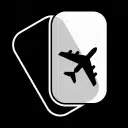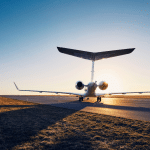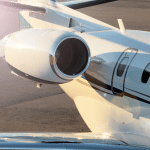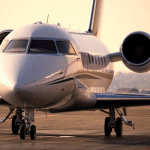How Airplanes and Jets Take Flight
Airplanes have been around for more than 100 years. The first one took flight on Dec., 17, 1903, when Orville and Wilbur Wright flew their basic plane over Kitty Hawk, NC, for just a few seconds. Their design was made from spruce wood and fabric. Since that day, airplanes have come a long way. Today’s airplanes are made almost entirely of metal, and some have a wingspan over 300 feet wide! Modern planes are now used for many things. Some fly passengers or products to their destination, while others are used for the military or scientific research. Airplanes come in all sorts of shapes and sizes. Although there are many kinds of planes, they all use the same basic systems to fly.
Planes and their engines work according to the laws of motion, which were discovered by Isaac Newton. There are three laws of motion: An object at rest usually stays at rest, while an object that is moving usually continues moving; the force needed to move an object is equal to the acceleration multiplied by the size of the object; and for every action, there is an equal and opposite reaction.
Airplanes and jets move at a speed that is related to the energy created by their engines. They are affected by the four forces of flight, which are weight, or the force of gravity pushing the plane downward; lift, the force that pushes the plane upward; thrust, the force produced by the engine that allows it to move forward; and drag, the force of air pushing against the plane in the opposite direction. The air that planes fly through is made up of molecules of gases such as nitrogen and oxygen, and different levels of the atmosphere have different concentrations of those molecules. This makes some layers of air have more weight than others. At higher altitudes, the air becomes thinner, with lower concentrations of gas molecules. Some planes fly better at certain altitudes because their engines are better suited to different levels of air pressure.
Planes are able to fly because of the energy provided by a propeller or a jet engine or, in some cases, electric or rocket engines. Propeller-driven planes are typically smaller. They combine a piston engine, which is an engine that creates motion by alternating pistons moving up and down, with a propeller. A propeller is a device with blades that spin. When a propeller spins, it creates thrust and overcomes drag. Planes driven by propellers are limited in how fast or high they can fly because propellers are limited in size; if the area where they spin is too small, a lot of energy is wasted, and if it is too large, the propellers can only spin so fast without making too much noise and not creating any more speed.
Jet engines are what power jet planes, which are the most common type of airplanes today. Jet engines consist of a chamber with many blades that are able to spin at very fast speeds. They work by sucking in air from the front of the airplane and compressing it so that the pressure rises. Fuel and a spark are then added to that air, which explodes through the other side of the engine. This reaction creates the thrust that drives the plane forward and overcomes drag. Jet planes do not have the same limitations that propeller-driven planes do and can fly much higher and faster. Jet planes typically fly at around 500 miles per hour when cruising in the air and around 120 miles per hour during takeoff and landing. Some even fly faster than the speed of sound, which is 768 miles per hour. When this happens, it is called supersonic speed. When a jet reaches supersonic speed, it makes a loud boom that can be heard below!
The engine’s job is to move the plane forward, but the wings are what create lift to move the plane upward. Wings on an airplane extend from the fuselage, or the body of the plane. They are usually curved at the top and flat on the bottom, and the two wings together are called an airfoil. They are designed to create changes in air pressure that allow the plane to move upward, stay suspended in the air, and then land. When a plane takes off, after enough energy is generated by the engines, the shapes of the wings create lift by lowering the pressure of the air above them and raising the pressure of the air below them, pushing air below and behind the plane. This results in the plane moving forward and upward. Once the plane is in the air, it is able to stay there by creating a downwash, which is downward-moving, higher-pressur air. To land, the speed and engine power are reduced, creating the opposite effect, lowering the pressure below the plane and causing the plane to descend back toward the ground.
Pilots control airplanes from inside, in a space called the cockpit. Inside the cockpit, the pilot has a radar system to see where other planes are in the air, and there are also gauges to show the speed and altitude of the plane, a lever called the throttle used to control the engines’ power, and a control wheel. The steering stick is what controls the direction of the plane, much like the steering wheel on a car. It is able to raise and lower the nose, or front, and wings of the plane. The pilot can use the controls to roll, pitch, or turn the plane. Rolling rotates the plane horizontally, pitching raises or lowers the entire plane, and turning changes the direction of the plane. Turning the plane is also called “yawing.”
Airplanes are continuing to improve in design and become more and more efficient. Some airplanes are now even controlled from the ground by remote control. Increasingly powerful engines allow planes to get us places faster than ever before. However, airplanes always have and always will follow the laws of motion, just as the Wright Brothers’ airplane did.
The following pages have more information about airplanes and jets and how they fly:
Are you ready to book your Houston to Dallas charter flight yet?
Our friendly, expert air charter agents are here to answer questions or start your quote today. Don`t wait, call now and we'll get you on your way to your destination!
Call 888-593-9066










